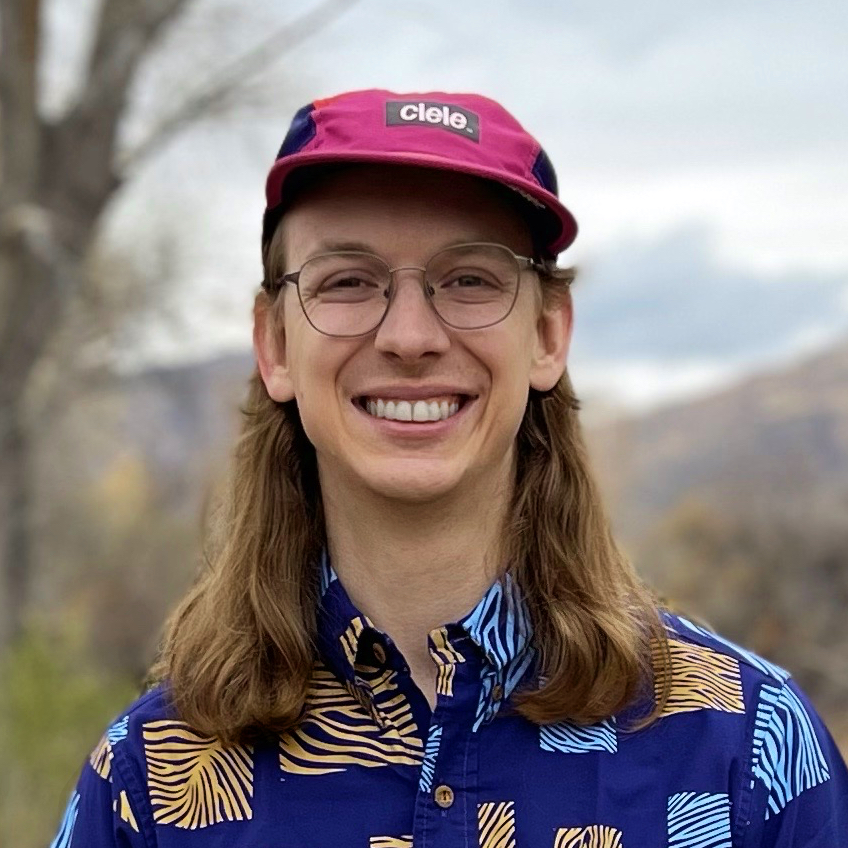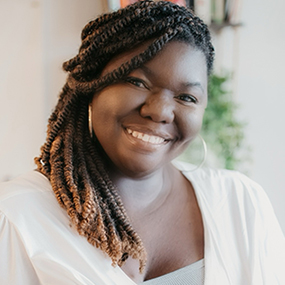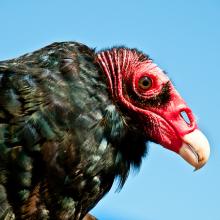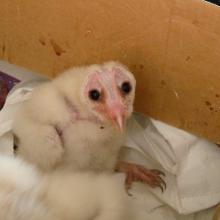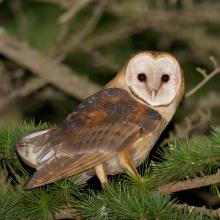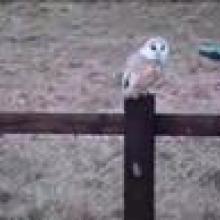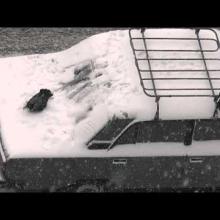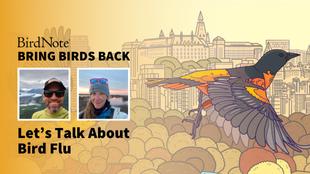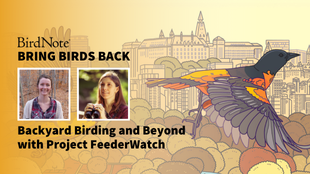

Join BirdNote tomorrow, November 30th!
Illustrator David Sibley and actor H. Jon Benjamin will face off in the bird illustration battle of the century during BirdNote's Year-end Celebration and Auction!

For Halloween, corvid researcher Kaeli Swift joins Tenijah for a show-and-tell of spooky birds. Corvids, vultures, and owls all have reputations as ominous and foreboding — and today, we’re digging into those ideas. Kaeli unpacks why the birds are seen as scary, shares cool facts beyond their mysterious façade, and explores conservation opportunities to help these birds.
Tenijah Hamilton: BirdNote Presents
[Wingbeats]
[Rain fades up; it’s a moderate storm, with some thunder in the distance]
Tenijah Hamilton: From BirdNote, this is Bring Birds Back. I'm Tenijah Hamilton.
[OMINOUS ORGAN MUSIC]
Tenijah Hamilton: For Halloween, we're going to the last aviary on the left, looking at some of the spooky and scary members of the bird world.
[THUNDER CRACK]
Tenijah Hamilton: We’re not talking about the shoebills or cassowaries today — though they are genuinely scary — but birds that loom large in our cultural imagination. Vultures — symbols of death. Owls — ghosts in the night. But one family of birds takes the spooky crown — corvids.
[Flock of crows cawing]
Tenijah Hamilton: The family includes crows, ravens, magpies, and jays. So we immediately thought of corvid expert Kaeli Swift. And she'll be our guide through some spooky birds today.
[Door creaks open, then slams; the rain is now muffled from inside]
Tenijah Hamilton: Welcome Kaeli!
Kaeli Swift: Thank you! Thank you for having me.
Tenijah Hamilton: How in the world did you end up in this field of study?
Kaeli Swift: My interest in crows and ravens started when I was an undergrad. And I was kind of exploring different kinds of scientific questions and, and what piques my interest the most, and that's a pretty high bar because I have ADHD. And so, you know, for something to like really capture me, it's gotta be awesome. So I was trying to figure out what that was. And I had always loved questions about animal behavior and intelligence and the relationships between sociology and, and cognition. And there was this growing body of work examining corvids and corvid brains. And so from there, I went on to graduate school where I got my masters and PHD focusing on American Crow behavior, specifically their funeral behaviors. And what I mean by that is that when crows see a dead crow they have this very visible and pretty consistent response. And most other animals don't seem to do that. And so I spent six years, actually, trying to explore that. Asking questions about what exactly that behavior looks like, why they do it. And through all of that, I just fell deeper and deeper in love with these — uh, this group of birds.
Tenijah Hamilton: I — I'm hooked. I'm in this. That is so interesting.
So you are a definitive corvid person. And so I think it's only fitting to start with them and to dig into the space they occupy in our imaginations throughout history, throughout literature. So can you tell me about this cultural image of the crow?
[Jaunty, playful music begins]
Kaeli Swift: Yeah. So this is a really fun area to explore because for most Westerners, when we think of crows and ravens, we have this really strong association with death, bad vibes, bad omens. And we see evidence of that throughout popular culture. From Edgar Allen Poe's poem “The Raven,” to the way that the calls of crows are used in movies and TV shows to denote something bad is about to happen, to their association with classic Disney villains. Our perspective of these birds is this kind of negative connotation. And one thing that I like to tell people is that, while that's very much true for a certain group of people, that's a very eurocentric version of these animals.
For example, in many parts of Asia, crows and ravens are used as avatars of fate. Rather than being you know, these scary things. These were helpful beings that guided people to their destinies.
Even if we look back in time through European cultures, we see that the connotation of these birds have changed a lot. For example, in ancient Greece, they were actually symbols of love and marriage. And seeing a crow was a good sign. It was an auspicious sign for a marriage. And so they definitely have this kind of spooky culture context now, but I like to remind people that, you know, human beings and human cultures around the globe are not a monolith. And if you start to poke around, you'll see these birds might have some really different contexts, depending on when and where you look.
[Jaunty, playful music ends]
Tenijah Hamilton: Got it. And also there's the whole murder of crows thing. Like who, who decided that was gonna be what we call them?
Kaeli Swift: That is one of the most common questions that I get. And I don't know who I can blame for that specifically. If I ever find out I will go and, you know, spit on their grave.
Tenijah Hamilton: Yeah. Fitting for Halloween!
Kaeli Swift: I do like to just remind people that, you know, terms like murder of crows or flamboyance of Flamingos are colloquialisms. So they're not scientific terms. They're pretty made up literary terms. And so we don't necessarily need to put too much stock. But again, it does underscore, like we don't call it a party of crows.
Tenijah Hamilton: Yeah.
Kaeli Swift: It, it captures— the fact that they got that name captures a moment in history in a particular culture where that made sense. That was a logical sort of tone to attribute to these animals. One other thing I like to share with people is that, in Europe, the backstory of why these animals are so, so, so strongly associated with death comes from a couple of different places. One of them is that, during some of the most violent periods of time in human history where Europeans were waging, you know, wars across the world leaving a lot of dead bodies. And that's naturally gonna attract scavengers.
And, you know, for some cultures being consumed and sort of reappropriated into the earth is how you move from this life to the next. But for European cultures, right, how we care for our deceased draws this really distinct line, right? We don't like to see our dead being eaten by animals. And so for that experience, right, of seeing dead or wounded soldiers being consumed by these animals, that would've been a really negative thing because we like to, you know, preserve our dead.
And then the next phase was the plague. Again, another moment in history where you have mass availability of human bodies. And then you also have those masks that the plague doctors wore that had these big extended beaks. And they used those to, you know, fill them with aromatics to help deal with the smell. But again you just have this thing where you're like— Oh, something looks like a bird, Raven. Oh, dead people. Oh, no. And so that's, that's kind of where that comes from.
But, interestingly, in medieval times, although crows were sort of omens of death, they weren't considered the cause of it. And so instead of being this really negative relationship, it was a more positive one because seeing this omen of impending doom gave people an opportunity to make peace with God. Get their affairs in order. So it was actually seen as like a positive heads up and be like, oh, okay. Something bad might happen. I should probably make sure I'm right in the world. And, uh. it was only later that then we were like, oh no, oh no, I don't like that. So get outta here birds, you scary, you scary birds.
[Flock of American Crows cawing]
Tenijah Hamilton: Yeah, get out of here you scary birds.
[Flock takes off with loud wingbeats, fades into distance]
Tenijah Hamilton: So corvids specifically are very smart birds. I've had guests prior on episodes where we've talked about the possibility of making friends with, you know, a, a murder of crows— you know what, we’re gonna change that. A party of crows, just like you said. A party of crows and then being just like, their friends. So they are super smart. They seem to remember faces and things like that. But is that why they're kind of spooky? Is that what really freaks people out? The fact that they do have these capabilities that feel not very common for, for, for bird creatures?
Kaeli Swift: Absolutely, actually. I get a lot of emails from folks who have maybe had a bad run in with a Crow or Raven. Maybe when they were kids, they threw stones at them. They were having a bad morning and there was a really noisy bird and they tried to shoo it away. Or maybe their dog, you know, on a walk, went after them. And now they're getting harassed and dive bombed because crows can recognize faces. And the functionality of that is for them to identify dangerous people and then treat them appropriately, meaning, as a threat. The idea that a wild animal can pick you out of a crowd and target you really, really does scare a lot of people.
Tenijah Hamilton: But you know what this says to me. It's kind of like well, well, well. Aren't these the consequences of my own decisions, it seems. You know, like these birds are keeping you— they're holding you accountable.
Kaeli Swift: They are holding you accountable and people do not like to be held to account. And so the idea that this animal could certainly freaks people out.
Tenijah Hamilton: So let's go a little deeper into kind of undoing this spooky reputation around corvids. So I would love if you would give me some cool facts and some fun facts about these birds.
Kaeli Swift: One aspect of their behavior that I might compel people to give these animals a second look is their quote unquote gift giving behavior.
[Playful bassoon music begins]
Many people who feed crows regularly and in specific spots have reported experiencing getting what they described as gifts. And these things could be feathers that have been left behind, screws, little pieces of plastic or metal. Sometimes recognizable objects. Sometimes little bits of garbage, in these places where the birds are being fed. There was this really viral example of a gentleman who got the pull tabs from bottles that had been threaded onto doug fir twigs. And there were two of them. And so he went so far as to describe that not only as a gift, but actually as a work of art. So this is common enough that it's real. Whether or not it's actually intended to be a gesture of gratitude. You know, from a scientific perspective, we can't speak to. I've tried really hard to just like ask crow's questions and get them to just provide answers. And they won't do it yet. So I can't, you know, I can’t yet get completely into their minds. There's certainly other less, um, whimsical explanations for that behavior. Like it could just be kind of an accident. They're curious, they carry things around. Then they see food. So they drop the boring thing they were carrying in favor of food, which is way more awesome. But until we have a definitive explanation for that behavior, I tell people if you get something that you perceive as a gift from a crow, lean into that feeling. That is amazing.
Kaeli Swift: And I don't wanna— I don't think it does anyone, uh, a disservice to imagine that this animal is maybe leaving something special behind just for them.
Tenijah Hamilton: Have you gotten a gift from a corvid?
Kaeli Swift: I have not.
Tenijah Hamilton: Are you a little stung by it?
Kaeli Swift: I would be more stung except that crow feeding has not been a consistent part of my life. I haven't always actually lived in areas where there are crows that would come to my backyard. I had one buddy for a long time that I fed near my office, but it was not in this, like, real consistent location pattern. So I rationalize it away.
Tenijah Hamilton: I got it. I got it. We have to do what we have to do to kind of soothe. So, I mean, these seem really fun, nuanced, complex birds.
And how do we make sure they stay a plenty? What kind of conservation opportunities are there to help corvids?
Kaeli Swift: So that's a great question. Part of the reason that humans have this really close link to these birds is that some of these species are what we call synanthropic, meaning very much exploiting the habitats that humans create. They're very strongly associated with them. House Crows, like Barn Owls, get their names because of how closely they associate with human structures. But that said, there are species that that is not their thing, particularly for island or forest dwelling species. And so some of these island species of crows, like the Hawaiian Crow, the Aga, the Mariana Crow, represent actually some of the most critically endangered birds in the world. In fact, the Hawaiian Crow is effectively extinct in the wild. Despite the fact that crows can feel like this really ubiquitous background animal. There are actually really dramatic conservation concerns for some of these more specialized species.
Tenijah Hamilton: Mm-hmm. And it seems like— and this is just me thinking, if they can get really close to human structures and human dwellings, it feels, like, very important that we continue building upon behaviors like keeping our cats inside, because these, um, particular birds feel like they could be pretty susceptible.
Kaeli Swift: Absolutely. In fact, cats were one of the leading causes of decline of the 'Alala, the Hawaiian Crow. Both through, you know, just, active predation, but also because cats spread disease like toxoplasmosis. And that was impacting the ʻAlalā. So yeah, so keeping cats inside is a really important thing.
Some of the other pending conservation concerns for these animals is that global climate change is projected to increase both the time of year and the latitude at which mosquitoes are thriving. And mosquitoes are vectors for West Nile Virus, which disproportionately affects corvids. It, it has almost a hundred percent mortality rate. So disease spread as facilitated by mosquitoes, which is being facilitated by climate change, could become a real concern for crows and ravens around the world.
[Driving, explorative music begins]
Tenijah Hamilton: OK, we're gonna take a quick break here, and when we come back, we’ve got more spooky birds, theories about ghost stories, and what Kaeli calls “the Virgin Mary thing”. Stick around.
[Driving, explorative music fades]
~MIDROLL~
Tenijah Hamilton: So I want to move on to another kind of bird that is also greatly maligned. And honestly, I could see a case for the spooky feels: Vultures.
[Turkey Vulture makes a throaty call]
Tenijah Hamilton: Man, I gotta say. I live in Georgia and I see a lot of Turkey Vultures. And, uh, A: they are way too big for comfort. They are huge. And immediately, you just— you see them and you're like, oh, something is dead. And that in itself is a little eerie, right?
Kaeli Swift: I also just think the physical appearance of vultures really freaks people out.
Tenijah Hamilton: They're not the cutest.
Kaeli Swift: They're not the cutest— I mean you know beauty is in eye of the beholder, but, um, most, yeah, most people have a hard time beholding vultures. The reason for their appearance is very much tied to their natural history. If you're gonna be sticking your head into the dirty carcass of some animal. Uh, you don't want your head feathers, which are the hardest parts of a bird's body to keep clean, coated in gunk. And so just losing that evolutionarily speaking was, was the right move. But it kind of gives them like— Ooh, okay.
Little bit of a, um, where are those critters from The Dark Crystal called? Skeksis.
[Skeksis making awful noises]
They're basically like exaggerated versions of vultures for a reason, cause they, they freak out children.
And they eat dead stuff, which again, sort of harkens back to aversion, particularly, you know, from a Eurocentric perspective, we tend to have a stronger aversion to dead things. We kind of get that sentiment of like: vultures; they're big. They rip animals apart, right? So we know that they could tear into our flesh if they found us dead. And all of that imagery, just like, ehhuhhe we don't like them. But they're critical keystone species that help both keep in check the availability and visibility of carrion. Which is important. And beyond just getting rid of bodies, they are really important in the process of stopping, um, or helping cease the spread of disease. Their stomach acids are so strong that they can actually break down things like anthrax and tuberculosis and rabies. And that is huge.
Tenijah Hamilton:. What are some things about vultures that are surprising?
Kaeli Swift: One thing is that monogamy is really uncommon in animals. The group of animals that it's the most common in is birds, actually. Mammals are very rarely monogamous. Birds, we see it more often, but there's usually kind of a lot of, you know, maybe they're like socially monogamous, but then there's kind of a lot of stuff. But black vultures are one of the rare examples of a very Monogamous bird. So if monogamy is an important part of the way that you define relationships, then you might appreciate that fact that they are one of the few monogamous animals out there. So, yeah. That's cute, you see 'em together, the little pairs and they're taking care of each other. Warms the cockles of my black heart.
Tenijah Hamilton: I hear that. What about the female California Condors? They have some special stuff that they can do.
Kaeli Swift: Right. They had the, like, Virgin Mary thing, like last year. Yes, yes. Yes.
[Angelic choir singing]
Tenijah Hamilton: The Virgin Mary thing. Please say more.
Kaeli Swift: So most vertebrates reproduce via sexual intercourse. But there are exceptions to that rule. And there was this case within the last couple of years of a female California Condor engaging in— the word is parthenogenesis, meaning she was able to reproduce in the absence of sperm. She laid a fertilized egg and it hatched into a kid and it's pretty freaking wild that she was able to do that. But you know, in the words of Jurassic park, uh, you know, life finds a way.
Tenijah Hamilton: Life finds a way. That is pretty wild.
So, Okay. So we know kind of, about the cool things, which again helps, kind of, counterbalance this societal idea we have about them. Which I appreciate. Cause like I said, they kind give me the ick sometimes. But we're working on it. Regardless, how do we help them? You mentioned that they're, you know, on the receiving end of some population decline and things like that.
Kaeli Swift: Yeah. So in North America, one of the truly easiest things we can do is legislate non-lead bullets. Lead, as most people know, is poisonous. It's not so good for you. It's not good to eat it. And what happens is, when hunters use lead bullets, which historically they have preferred because they believe that it performs better, more instantly lethally and because it's less expensive. They'll go out, you know, they shoot game. Maybe they lose that animal. They're unable to track it down. And so you have the whole animal sitting in the woods, later detected by a vulture. Or the other really common thing is hunters will process the animal, field dress it, very common thing. They'll leave the gut piles behind. Normally that could actually be a really positive thing for scavengers. A positive way that we could be creating food resources for scavengers. But if those gut piles or those bodies are contaminated with lead. That can be a serious problem. And we see that in many large birds of prey from Bald Eagles, to Golden Eagles, to vultures, and really specifically California Condors. The state of California, actually, because of that, has legislated so that you cannot use lead bullets. And so that's a really simple thing that we can do. And now, contemporarily, if you are a hunter, know that there are products on the market that perform just as well as lead bullets and can be relatively cost comparable. And so there, there's really not an excuse anymore.
Tenijah Hamilton: That feels like an easy way to help out vultures, that's great to hear. So I want to go to our last group of birds:
[Great-horned Owl hooting]
Tenijah Hamilton: Owls. Of the list of birds that we've talked about so far, it's like, are they really that maligned? Tell us more.
Kaeli Swift: So I would agree with you. I don't think owls are particularly maligned. However, I have a completely unsubstantiated theory that Barn Owls are how ghost stories originated. So the thing about owls is I think you're right. Culturally, we show them a lot of reverence and respect. And if you look around the world, that's, that's actually often the case. But if you have ever been out at night by yourself, walking around near a barn, and you've had one of those birds swoop by you and screech…
[Nighttime forest ambience; crickets are chirping, there are light footsteps. The footsteps stop, and something swoops from right to left; a Barn Owl screeches harshly]
Kaeli Swift: …you will know what it's like to poop your pants. It is so freaky. It is like they make these horrible, horrible sounds. Look, I am not trying to encourage people to malign these birds. I'm just saying, I'm just saying that if you want a reason to fear death, go out Barn Owl owling in the night alone. Because it's intense. The sounds they make. They'll haunt your dreams.
Tenijah Hamilton: I felt fine about owls and I do not appreciate this, because why are you — this episode said, hey, we're gonna get you to love your little corvid friends, but we're gonna get you to cast some doubts on the owls. Cool. No big deal.
Kaeli Swift: Yeah. Yeah.
Tenijah Hamilton: Um, that being said, again, I come back to this question: How do we help them? What kind of conservation efforts are going on right now to make sure that, um — I'm not gonna call them owl friends, our owl contemporary peers who live amongst us. How do we make sure that continues?
Kaeli Swift: Yeah. Great question. So the number one thing that you can do is stop using rodenticide. Where I live right now, I get rodents and small mammals in my house, so I appreciate that that is not a great situation. Um, but poison is not the path my friends. If you feed rodents poison, they don't die on the spot. They go out, back into nature and then they get eaten by owls and other birds of prey or crows or ravens. Uh, and then you're just, you know, perpetuating that poison throughout the food chain. And particularly in cities — in fact, a few years ago, I picked up a Red-tailed Hawk on the side of the road that, rather than having been hit by a car, was exhibiting symptoms that suggested that it had eaten rodenticide. So please be considerate. Again, I get it. There's no reason to just accept that you have rats or mice pooping all over your house. That's not a great situation. But there are better, much less ecologically impactful ways to deal with that than rodenticide.
Tenijah Hamilton: Yes. Okay. Great. I appreciate that. And it's really important to make sure that the decisions we make are not hurting the wider kind of ecological community.
[CONCLUSIVE ORGAN MUSIC]
Tenijah Hamilton: This has been truly enlightening. So in conclusion, we have that a lot of people are afraid of birds. And maybe just little or with certain birds or maybe they're very scared. Uh, my best friend and her entire family is terrified of birds. Little birds, too. I don't know what to do there. But, I think in the spirit of Halloween it's okay to say there's nothing to really be afraid of, except the consequences of your own decisions, as we talked about earlier with our ravens, right?
Kaeli Swift: I love that. Yes. Totally on board. I love that summary. Thank you so much for that insight.
Tenijah Hamilton: Thank you so much. I'm just regurgitating what you said. They're just— they're just animals. So thank you so much Kaeli. This has been a blast and I wanna keep learning more about this. So stay tuned. Stay tuned.
Kaeli Swift: Yeah. It was so fun to talk to you about all this stuff.
Tenijah Hamilton: You can find Kaeli Swift on Twitter, where she’s appropriately AT Corvid Research. She runs a weekly game called “Crow or No?” and shares a photo of a corvid. And then you try to guess if it’s a species of crow or not. It’s delightful.
Bring Birds Back is produced by Mark Bramhill and me, Tenijah Hamilton. Our production assistant is Sam Johnson. Our fact checker is Conor Gearin. Our content director, and editor this season, is Allison Wilson. Music is by Cosmo Sheldrake, Blue Dot Sessions, and Sam Johnson. Special thanks to Viki Merrick.
About guest Kaeli Swift:
Dr. Swift earned her PhD from the University of Washington where she studied American crow behavior, with a special emphasis on behaviors around death. She is currently a postdoctoral researcher at the University of Washington, where she is studying the breeding ecology of the Tinian monarch. You can read her popular science articles on her blog, corvidresearch.blog. You can also find her on Twitter, Instagram, and TikTok at the @corvidresearch handle. Video, audio, and print reports of her research have been featured by: National Geographic, PBS, the New York Times, The Atlantic, Ologies podcast, Science Friday and many others.

